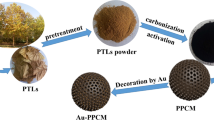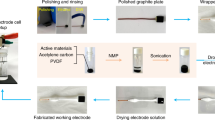Abstract
Porous solids are of great technological importance due to their ability to interact with gases and liquids not only at the surface, but throughout their bulk1. Although large pores can be produced and well controlled in a variety of materials2, nanopores in the range of 2 nm and below (micropores, according to IUPAC classification) are usually achieved only in carbons or zeolites. To date, major efforts in the field of porous materials have been directed towards control of the size, shape and uniformity of the pores. Here we demonstrate that porosity of carbide-derived carbons (CDCs)3,4,5,6,7,8,9 can be tuned with subångström accuracy in a wide range by controlling the chlorination temperature. CDC produced from Ti3SiC2 has a narrower pore-size distribution than single-wall carbon nanotubes or activated carbons; its pore-size distribution is comparable to that of zeolites. CDCs are produced at temperatures from 200–1,200 °C as a powder, a coating, a membrane or parts with near-final shapes, with or without mesopores. They can find applications in molecular sieves, gas storage, catalysts, adsorbents, battery electrodes, supercapacitors, water/air filters and medical devices.
This is a preview of subscription content, access via your institution
Access options
Subscribe to this journal
Receive 12 print issues and online access
$259.00 per year
only $21.58 per issue
Buy this article
- Purchase on Springer Link
- Instant access to full article PDF
Prices may be subject to local taxes which are calculated during checkout




Similar content being viewed by others
References
Davis, M.E. Ordered porous materials for emerging applications. Nature 417, 813–821 (2002).
Joo, S.H. et al. Ordered nanoporous arrays of carbon supporting high dispersions of platinum nanoparticles. Nature 412, 169–172 (2001).
Gogotsi, Y.G. & Yoshimura, M. Formation of carbon films on carbides under hydrothermal conditions. Nature 367, 628–630 (1994).
Gogotsi, Y.G., Jeon, J.D. & McNallan, M.J. Carbon coatings on silicon carbide by reaction with chlorine-containing gases. J. Mater. Chem. 7, 1841–1848 (1997).
Ersoy, D., McNallan, M.J. & Gogotsi, Y.G. Carbon coatings produced by high temperature chlorination of silicon carbide ceramics. Mater. Res. Innov. 5, 55–62 (2001).
Hutchins, O. Method for the production of silicon tetrachlorid. US patent 1,271,713 (1918).
Boehm, H.P. & Warnecke, H.H. in Proc. 12th Biennial Conf. Carbon 149–150 (Pergamon, Oxford, 1975).
Gordeev, S.K., Kukushkin, S.A., Osipov, A.V. & Pavlov, Y.V. Self-organization in the formation of a nanoporous carbon material. Phys. Solid State 42, 2314–2317 (2000).
Fedorov, N.F. Untraditional solutions in chemical technology of carbon adsorbents. Russ. Chem. J. 39, 73–83 (1995).
Claye, A. & Fischer, J.E. Short-range order in disordered carbons: where does the Li go? Electrochim. Acta 45, 107–120 (1999).
Shiflett, M.B. & Foley, H.C. Ultrasonic deposition of high-selectivity nanoporous carbon membranes. Science 285, 1902–1905 (1999).
Rodriguez-Reinoso, F. & Sepulveda-Escribano, A. in Handbook of Surfaces and Interfaces of Materials (ed. Nalwa, H.S.) 309–355 (Academic, San Diego, 2001).
Derycke, V., Martel, R., Radosavljević, M., Ross, F.M. & Avouris, P. Catalyst-free growth of ordered single-walled carbon nanotube networks. Nano Lett. 2, 1043–1046 (2002).
Gogotsi, Y., Welz, S., Ersoy, D.A. & McNallan, M.J. Conversion of silicon carbide to crystalline diamond-structured carbon at ambient pressure. Nature 411, 283–287 (2001).
Barsoum, M.W. The Mn+1AXn phases: a new class of solids. Prog. Solid State Chem 28, 201–281 (2000).
Kyutt, R.N., Smorgonskaya, E.A., Danishevski, A.M., Gordeev, S.K. & Grechinskaya, A.V. Structural study of nanoporous carbon produced from polycrystalline carbide materials: small-angle X-ray scattering. Phys. Solid State 41, 1359–1363 (1999).
Ferrari, A.C. & Robertson, J. Interpretation of Raman spectra of disordered and amorphous carbon. Phys. Rev. B 61, 14095–14107 (2000).
El-Raghy, T. & Barsoum, M.W. Diffusion kinetics of the carburization and silicidation of Ti3SiC2 . J. Appl. Phys. 83, 112–119 (1998).
Leis, J., Perkson, A., Arulepp, M., Nigu, P. & Svensson, G. Catalytic effect of metals of the iron subgroup on the chlorination of titanium carbide to form nanostructural carbon. Carbon 40, 1559–1564 (2002).
Gogotsi, Y. et al. Formation of carbon coatings on SiC fibers by selective etching in halogens and supercritical water. Ceram. Eng. Sci. Proc. 19, 87–94 (1998).
Yanul', N.A. et al. Nanoporous carbon materials with varied porosity and specific features of their interaction with water. Russ. J. Appl. Chem. 72, 2159–2163 (1999).
Baughman, R.H., Zakhidov, A.A. & de Heer, W.A. Carbon nanotubes - the route toward applications. Science 297, 787–792 (2002).
Burke, A. Ultracapacitors: why, how, and where is the technology? J. Power Sources 91, 37–50 (2000).
Nijkamp, M.G., Raaymakers, J.E.M.J., van Dillen, A.J. & de Jong, K.P. Hydrogen storage using physisorbtion — materials demands. Appl. Phys. A. 72, 619–623 (2001).
Schlapbach, L. & Züttel, A. Hydrogen-storage materials for mobile applications. Nature 414, 353–358 (2001).
Mariwala, R.K. & Foley, H.C. Calculation of micropore sizes in carbogenic materials from the methyl chloride adsorption isotherm. Ind. Eng. Chem. Res. 33, 2314–2321 (1994).
Tuinstra, F. & Koenig, J.L. Raman spectrum of graphite. J. Chem. Phys. 53, 1126–1130 (1970).
Acknowledgements
Thanks are due to W.-H. Shih, Drexel University, for help with nitrogen BET measurements. The work at Drexel University was supported by the Defence Advanced Research Projects Agency through an Office of Naval Research (ONR) contract. The TEM used is operated by the Regional Materials Characterization Facility at the University of Pennsylvania. Purchase of the Raman spectrometer and SEM were supported by National Science Foundation (NSF) grants DMR-0116645 and BES-0216343. The work at Pennsylvania State University was supported by ONR grant N00014-00-1-0720 and NSF grant DMR-0103585. M.B. was supported by NSF grant DMR-0072067.
Author information
Authors and Affiliations
Corresponding author
Ethics declarations
Competing interests
The authors declare no competing financial interests.
Supplementary information
Supplementary Fig. S1
Supplementary Fig. S2 (PDF 1013 kb)
Supplementary Fig. S3
Supplementary Table S1
Rights and permissions
About this article
Cite this article
Gogotsi, Y., Nikitin, A., Ye, H. et al. Nanoporous carbide-derived carbon with tunable pore size. Nature Mater 2, 591–594 (2003). https://doi.org/10.1038/nmat957
Received:
Accepted:
Published:
Issue Date:
DOI: https://doi.org/10.1038/nmat957
This article is cited by
-
Effect of carbon enrichment in polymer-derived ceramers on the electrochemical characteristics of their derived carbons
Journal of Materials Science (2024)
-
Teaching electrochemistry and student participation in the development of sustainable electricity generation/storage devices at the Institute of Chemistry of the University of Tartu
Journal of Solid State Electrochemistry (2024)
-
Advances in Supercapacitor Development: Materials, Processes, and Applications
Journal of Electronic Materials (2023)
-
The review of advances in interfacial electrochemistry in Estonia: electrochemical double layer and adsorption studies for the development of electrochemical devices
Journal of Solid State Electrochemistry (2023)
-
Electronic structure, elastic and magnetic properties of the binary intermetallics RFe2 (R = Eu, Gd and Tb)
Journal of Computational Electronics (2022)



